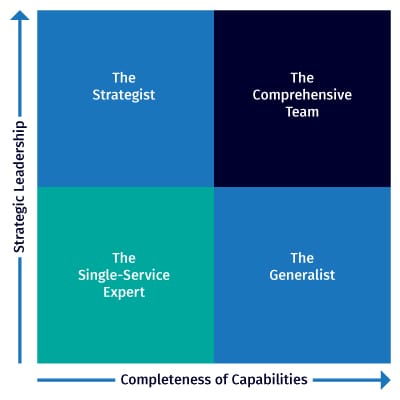There’s been a lot of market hype over the last few years about managed IT support and Managed Service Providers (MSPs) – in addition to the already dizzying array of other IT provider choices. MSPs differ in their capabilities but, in general, each can help you proactively manage your IT infrastructure (i.e., servers, network and PCs) for a monthly fee versus the old model of waiting until there's a problem and then reacting to it. Some may also act as consultants or advisors to you and your internal IT team – if one exists.
But there are many IT provider choices in addition to the popular MSPs, and if you don’t know how to vet them, you could become quickly overwhelmed – or worse, make the wrong choice based on bad advice or a lack of understanding. Some providers can fill a gap in your technology repertoire. They solve a problem for you, but not necessarily with a greater vision for your entire technology strategy. Others provide strategic advice, but don’t actually help you implement or keep systems up and running on a daily basis.
To help you understand the range and choice you have when choosing an IT service provider, it’s helpful to think about IT services as existing along two axes: capability and strategy. On one axis we have “strategic leadership,” a range that runs from single-service experts to consultative strategists – this type of support can help you plan and design your technology to meet your needs and goals. On the other axis we have “completeness of capabilities,” which describes a provider’s range of hands-on services and IT expertise.
All MSPs and IT service providers sit somewhere on this graph.
The Single-Service Expert
Those with fewer capabilities and limited ability to guide you strategically on what’s best to support your business plan sit in the lower left quadrant. Examples of single-service experts include: data centers, cloud providers, security service providers, value-added resellers and OEMs. They’re sort of like order takers – “Tell me what you need, and I’ll give it to you.” They’re good at what they do, but what they do is limited and specific. Like subcontractors helping build your dream house, they’re niche providers, excellent at painting, or electrical work, or hardwood flooring – but not all of the above.
This type of expertise is great if you're clear on exactly what you need. But it comes with a risk. You have to stitch together a whole bunch of providers into a solution that works for your specific business. It’s sort of like deciding to build a house on your own without hiring a general contractor. You search out the best painters, electricians, plumbers, masons and carpenters, but who’s to say they’ll work well together? And how do you manage their schedules and get them to communicate?
Similar problems arise when you source external IT providers on your own without taking your greater technology ecosystem into consideration. It becomes a lot of work to keep everything functioning together, and no one person (besides you) has an eye on the whole picture.
The Strategist
As you climb the graph to the upper left quadrant, you encounter strategic consultants who can come in and advise you on most, if not all, aspects of your IT (i.e., servers, security, network, PCs and applications). CIOs and CTOs sit in this quadrant as well. They’re advice-givers with an elevated ability to guide you. They can create a broader vision and plan for your IT, and provide strategic leadership, helping lead you to fulfilled IT goals. But they’re not implementers; they won’t do the dirty work for you. Their breadth of capability is limited, partly because they’re typically only one person.
In our house-building analogy, the strategist is an architect who designs your dream home, hands you the plans, then disappears, leaving it up to you to get it built. They’ll design a whole system for you, one that works together, with components that will cooperate and blend. But they won’t actually hammer the nails. You have to do that yourself or hire someone else, so if you’re not clear on how to execute, you’ll run into trouble.
The Generalist
Over in the lower right quadrant, we have providers that can handle a wide range of capabilities, which makes them great at implementing an IT strategy you’ve devised. These are your general contractors; they take charge of getting everything done. They might be a good solution if you already have a concrete vision or simply need a partner for holistic general maintenance – someone who can keep you tuned up and swoop in when your roof springs a leak, so to speak. They solve problems and can help you avoid (or clean up after) disasters.
The Comprehensive Team
Two things converge in the upper right quadrant:
-
A heightened ability to lead you through the creation and management of an on-going IT strategy
-
A wide scope of capabilities to bring the strategy to life
In this quadrant, you'll find more than just an MSP. You’ll find a comprehensive IT team that can help you strategize, implement the best solutions, keep them maintained and step in any time you need support. This team acts as a strategic Business Advancement Engine™.
Like a general contractor with an in-house architect and the resources to stay connected to your home in the long term, they can help you lay a technology foundation, but also stick with you as it and your needs evolve. Not only will they patch your roof if it springs a leak, but they’ll maintain your roof so well it won’t spring a leak in the first place, making sure everything is always functioning and running as efficiently and securely as possible. They can even sense when a light bulb is out, and replace it without bothering you.
It’s a broad scope of competency that can be customized to your particular needs, so this type of company is ideal if you want a true technology partner. They can take you from the strategic phase through implementation and day-to-day operations.
ADDITional resource: 9 Questions to Ask Before Choosing an IT Partner
 Take the stress out of finding the right IT partner. This free guide outlines the 9 most important questions you need to ask before choosing an IT partner.
Take the stress out of finding the right IT partner. This free guide outlines the 9 most important questions you need to ask before choosing an IT partner.
Download the free guide today.
So Where Do MSPs Fall on This Quadrant?
Most fall in the lower middle of the quadrant, as depicted in the diagram below.
.jpg?width=400&name=Task-43783---LAZOR-Simple-Graphic-for-IT-Partners-Blog%20(1).jpg) They’re often not truly experts in every area of IT. They might be great at advising on workstations, servers and mobile devices (the hardware side) but weaker on software, particularly when it comes to integrating systems, selecting an ERP or CRM system or building your own applications. Typically, they position themselves as having a particular type of expertise within which they can execute many different tasks. But they don’t offer comprehensive strategic insight to help you create a greater vision for your IT.
They’re often not truly experts in every area of IT. They might be great at advising on workstations, servers and mobile devices (the hardware side) but weaker on software, particularly when it comes to integrating systems, selecting an ERP or CRM system or building your own applications. Typically, they position themselves as having a particular type of expertise within which they can execute many different tasks. But they don’t offer comprehensive strategic insight to help you create a greater vision for your IT.
If you already have “general contractor” experience of your own (so to speak), and you know exactly what you want and have the talent on your team to implement, manage and maintain, you may not need a comprehensive IT team. But most companies can’t afford or aren’t able to retain the talent and resources in-house to strategize what they need, build it out and keep it running efficiently and securely. Even a seasoned, highly attuned IT leader can benefit from a partnership with a comprehensive technology partner.
Lazorpoint’s IT Peace of Mind™ program includes managed IT services and a broad scope of competency to solve your technology challenges – in essence, it gives you the confidence your business needs to grow. We can help you reimagine your entire technology environment or meet you where you’re at with on-demand expertise.
If you’re looking for a true comprehensive IT partner, talk to an expert today.
